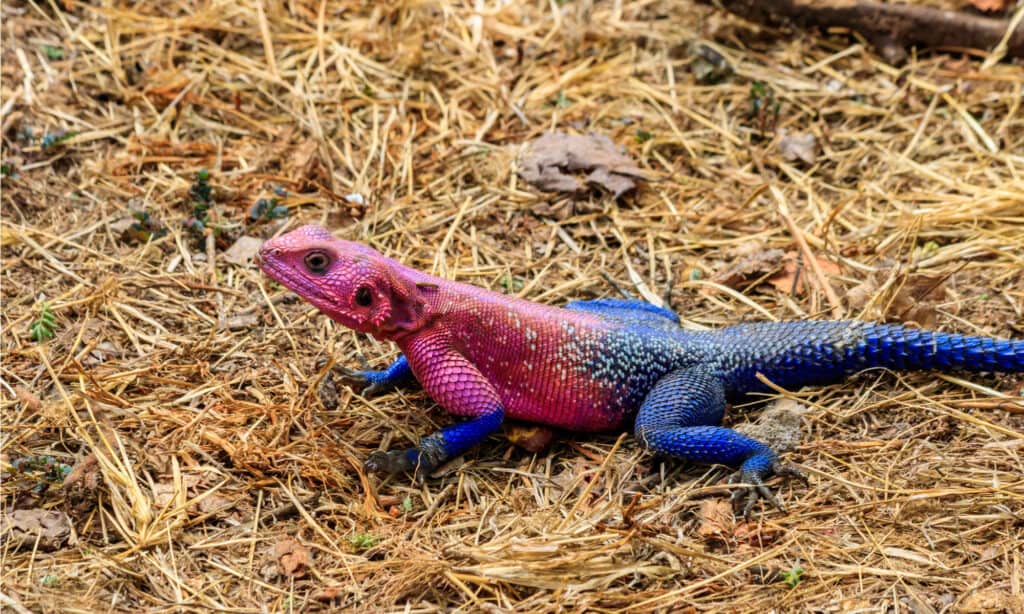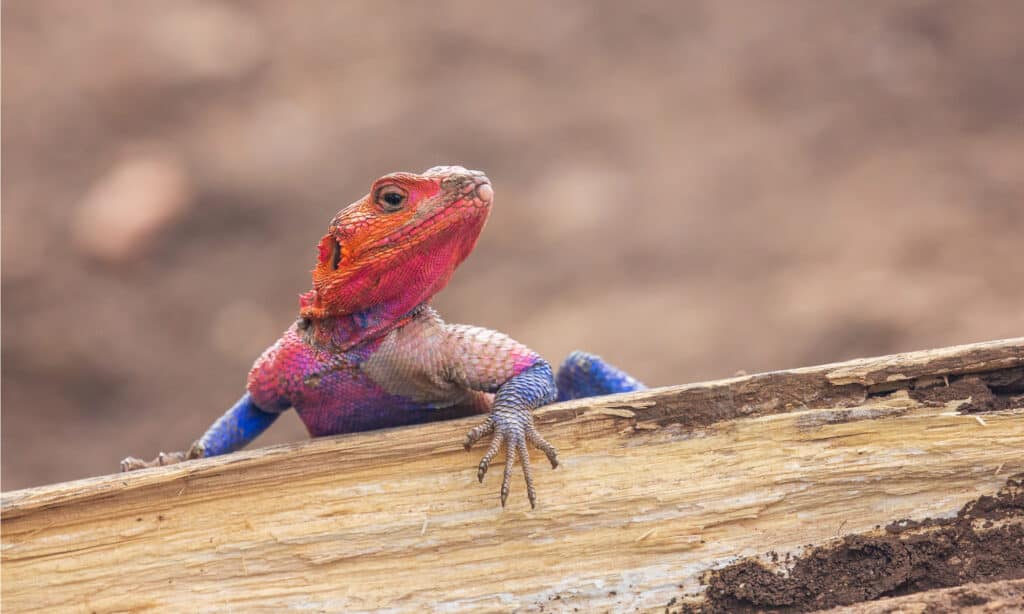Lizards are certainly a colorful bunch of reptiles, but what’s the most colorful lizard of them all? Could it perhaps be the panther chameleon or the jeweled lacerta? It’s actually the rainbow lizard, known as the common agama or the red-headed rock agama! So, what is a rainbow lizard, and why is it so vibrant and colorful?
Read on as we take a closer look at this stunning reptile and what makes it so special.
What is a Rainbow Lizard?

Dominant male rainbow lizards are typically the most colorful.
©Matt Jeppson/Shutterstock.com
Rainbow lizard is a common name for the common agama (Agama agama). This lizard goes by a few different common names, like the rainbow agama and the red-headed rock agama.
While the female of the species is typically drabber brown and orange, the male displays a vibrant range of colors. These colors range from bright red and orange around the lizard’s head and neck to vivid blue, green, and yellow on its body, legs, and tail.
Taxonomically, the common agama is classified within the Agamidae family. This group contains around 300 different species of dragon lizards. Most lizards, including the rainbow lizard, have a similar head shape, size, and dragon-like appearance. Some of the better-known species in this family include the bearded dragon and the also-colorful Mwanza flat-headed rock agama.
Visually, aside from its unusually wide range of colors, the rainbow agama’s appearance is typical of other agamid lizards. It has a stout, strong body, triangular head, and a long tail that make up much of its body length. Its claws are short, sharp, and ideal for climbing and traversing its dry, rocky native habitats.
Like most dragon lizards, the rainbow lizard is diurnal and prefers dry, arid desert-like conditions. It has a wide geographical range, from parts of Africa to India and even South Florida in the United States. Rainbow lizards are a highly social and territorial species, and as we’ll cover in more detail below, their coloration determines their place in the species’ social hierarchy.
Why Are Rainbow Lizards So Colorful?

A rainbow lizard’s coloration signals to other lizards whether it is a dominant male, a subordinate male, or a female.
©Bob Ascott/Shutterstock.com
Interestingly, the rainbow lizard’s wide range of colors plays an important role in the lizards’ social hierarchy. A lizard’s coloration signals its place within this elaborate hierarchy.
Dominant male rainbow lizards have more vivid colors and typically have bright red heads and necks. However, more submissive or subordinate males have more subdued colors, with more grayish-green heads and much duller body coloration. Juvenile and female rainbow lizards are also far drabber in color than the dominant adult males.
As we learned earlier, rainbow agamas, particularly the males, are extremely territorial. They commonly fight one another to claim territory within their habitats.
Additionally, because they are highly social, these lizards usually live in large groups. Within these groups is a single dominant male, or “cock,” who leads the group. This individual is typically the most vibrant in color. Dominant males are easily identified by their bright red or orange heads and stunning blue and green bodies.
Aside from the dominant male, there are also typically at least 6 to 10 females within a typical social group, as well as a few submissive or subordinate males. The females and subordinate males usually have far less vibrant body colors. They most often have grayish or drab, olive-green heads and bodies with occasional splashes or patches of orange and yellow.
Where Do Rainbow Agamas Live?

Rainbow agamas mostly live in Central Africa.
©Olha Solodenko/Shutterstock.com
Rainbow agamas are native primarily to sub-Saharan Central Africa. They have a fairly wide geographical range within the continent, residing in Cameroon, Uganda, Chad, Ghana, and Mali. They also live in India and Madagascar.
While the lizards prefer rural areas, they have also been forced to establish themselves in more urban cities and towns. Like with many animal species, this is due to habitat loss from humans encroaching on and destroying their natural habitats. However, rainbow lizards have proven to be somewhat beneficial to urban areas, as they have voracious appetites for various troublesome insect pests.
In addition to their native range, rainbow lizards have been introduced to and established themselves in South Florida. This is mostly thanks to the species’ recent popularity in the pet trade. As exotic pets, these lizards must be kept in very hot and dry conditions, similar to their native habitat, in order to thrive. Because they are so territorial and competitive, they must be housed alone.
What Do Rainbow Agamas Eat?

Like most agamid lizards, rainbow lizards are omnivores but prefer to eat insects.
©Luca Nichetti/Shutterstock.com
IMAGE NEEDED: A picture of a rainbow agama. Possible caption: Like most agamid lizards, rainbow lizards are omnivores but prefer to eat insects.
Rainbow lizards are technically omnivores. They commonly eat a variety of insects and small animals in addition to vegetation in the form of surrounding plant growth like flowers and fruits. However, they strongly prefer primarily feeding on insects, especially in the wild.
The main foods rainbow agamas eat include:
- Ants
- Termites
- Beetles
- Grasshoppers
- Small mammals, most often small and baby rodents (less frequently)
- Other, smaller lizards (less frequently)
In captivity, rainbow agamas should eat a mixture of insects and vegetation. The plant matter they eat as pets should mostly consist of highly nutritious dark, leafy greens. Common feeder insects appropriate for rainbow lizards include superworms, crickets, and dubia roaches.
The photo featured at the top of this post is © Bob Ascott/Shutterstock.com
Thank you for reading! Have some feedback for us? Contact the AZ Animals editorial team.






